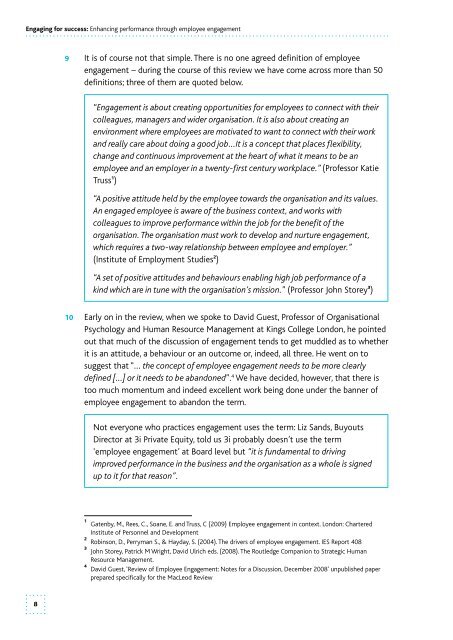3ytgeaf
3ytgeaf
3ytgeaf
You also want an ePaper? Increase the reach of your titles
YUMPU automatically turns print PDFs into web optimized ePapers that Google loves.
Engaging for success: Enhancing performance through employee engagement<br />
9 It is of course not that simple. There is no one agreed definition of employee<br />
engagement – during the course of this review we have come across more than 50<br />
definitions; three of them are quoted below.<br />
“Engagement is about creating opportunities for employees to connect with their<br />
colleagues, managers and wider organisation. It is also about creating an<br />
environment where employees are motivated to want to connect with their work<br />
and really care about doing a good job…It is a concept that places flexibility,<br />
change and continuous improvement at the heart of what it means to be an<br />
employee and an employer in a twenty-first century workplace.” (Professor Katie<br />
Truss 1 )<br />
“A positive attitude held by the employee towards the organisation and its values.<br />
An engaged employee is aware of the business context, and works with<br />
colleagues to improve performance within the job for the benefit of the<br />
organisation. The organisation must work to develop and nurture engagement,<br />
which requires a two-way relationship between employee and employer.”<br />
(Institute of Employment Studies 2 )<br />
“A set of positive attitudes and behaviours enabling high job performance of a<br />
kind which are in tune with the organisation’s mission.” (Professor John Storey 3 )<br />
10 Early on in the review, when we spoke to David Guest, Professor of Organisational<br />
Psychology and Human Resource Management at Kings College London, he pointed<br />
out that much of the discussion of engagement tends to get muddled as to whether<br />
it is an attitude, a behaviour or an outcome or, indeed, all three. He went on to<br />
suggest that “… the concept of employee engagement needs to be more clearly<br />
defined […] or it needs to be abandoned”. 4 We have decided, however, that there is<br />
too much momentum and indeed excellent work being done under the banner of<br />
employee engagement to abandon the term.<br />
Not everyone who practices engagement uses the term: Liz Sands, Buyouts<br />
Director at 3i Private Equity, told us 3i probably doesn’t use the term<br />
‘employee engagement’ at Board level but “it is fundamental to driving<br />
improved performance in the business and the organisation as a whole is signed<br />
up to it for that reason”.<br />
1<br />
2<br />
3<br />
4<br />
Gatenby, M., Rees, C., Soane, E. and Truss, C (2009) Employee engagement in context. London: Chartered<br />
Institute of Personnel and Development<br />
Robinson, D., Perryman S., & Hayday, S. (2004). The drivers of employee engagement. IES Report 408<br />
John Storey, Patrick M Wright, David Ulrich eds. (2008). The Routledge Companion to Strategic Human<br />
Resource Management.<br />
David Guest, ‘Review of Employee Engagement: Notes for a Discussion, December 2008’ unpublished paper<br />
prepared specifically for the MacLeod Review<br />
8


